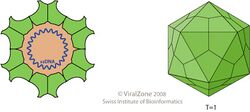Biology:Circovirus
| Circovirus | |
|---|---|

| |
| Virus classification | |
| (unranked): | Virus |
| Realm: | Monodnaviria |
| Kingdom: | Shotokuvirae |
| Phylum: | Cressdnaviricota |
| Class: | Arfiviricetes |
| Order: | Cirlivirales |
| Family: | Circoviridae |
| Genus: | Circovirus |
Circovirus is a genus of viruses, in the family Circoviridae. Birds (such as pigeons[1] and ducks[2]) and pigs[3] serve as natural hosts, though dogs have been shown to be infected as well.[4] It is a single stranded DNA virus (ssDNA). There are 49 species in this genus. Some members of this genus cause disease: PCV-1 is non pathogenic, while PCV-2 causes postweaning multisystemic wasting syndrome (PMWS).[5][6]
Taxonomy
The following species are recognized:
- Barbel circovirus
- Bat associated circovirus 1
- Bat associated circovirus 2
- Bat associated circovirus 3
- Bat associated circovirus 4
- Bat associated circovirus 5
- Bat associated circovirus 6
- Bat associated circovirus 7
- Bat associated circovirus 8
- Bat associated circovirus 9
- Bat associated circovirus 10
- Bat associated circovirus 11
- Bat associated circovirus 12
- Bat associated circovirus 13
- Beak and feather disease virus
- Bear circovirus
- Canary circovirus
- Canine circovirus
- Chimpanzee associated circovirus 1
- Civet circovirus
- Duck circovirus
- Elk circovirus
- European catfish circovirus
- Finch circovirus
- Goose circovirus
- Gull circovirus
- Human associated circovirus 1 (HCirV-1)
- Mink circovirus
- Mosquito associated circovirus 1
- Penguin circovirus
- Pigeon circovirus
- Porcine circovirus 1
- Porcine circovirus 2
- Porcine circovirus 3
- Porcine circovirus 4
- Raven circovirus
- Rodent associated circovirus 1
- Rodent associated circovirus 2
- Rodent associated circovirus 3
- Rodent associated circovirus 4
- Rodent associated circovirus 5
- Rodent associated circovirus 6
- Rodent associated circovirus 7
- Starling circovirus
- Swan circovirus
- Tick associated circovirus 1
- Tick associated circovirus 2
- Whale circovirus
- Zebra finch circovirus
Structure
Viruses in Circovirus are non-enveloped, with icosahedral and round[clarification needed] geometries, and T=1 symmetry. The diameter is around 17 nm. Genomes are circular and non-segmented.[5]
The virions of Circoviruses are surprisingly small, with diameters ranging from 17 up to 22 nm.[7]
| Genus | Structure | Symmetry | Capsid | Genomic arrangement | Genomic segmentation |
|---|---|---|---|---|---|
| Circovirus | Icosahedral | T=1 | Non-enveloped | Circular | Monopartite |
Life cycle
Viral replication is nuclear. Entry into the host cell is achieved by penetration. Replication follows the ssDNA rolling circle model. DNA templated transcription, with some alternative splicing mechanism is the method of transcription. The virus exits the host cell by nuclear egress, and nuclear pore export. Birds and pigs serve as the natural host. Transmission routes are fecal-oral and parental.[5]
| Genus | Host details | Tissue tropism | Entry details | Release details | Replication site | Assembly site | Transmission |
|---|---|---|---|---|---|---|---|
| Circovirus | Birds; pigs | None | Cell receptor endocytosis | Budding | Nucleus | Nucleus | Horizontal; oral-fecal |
Genome
Circovirus has a monopartite, circular, and ssDNA genome of between 1759 and 2319nt, making it possibly the virus of shortest genome size in mammal viruses. The virus replicates through an dsDNA intermediate initiated by the Rep protein. Two major genes are transcribed from open reading frame (ORF) 1 and 2. ORF1 encodes Rep and Rep' for initiation of rolling-circle replication; ORF2 encodes Cap, the only structural and most immunogenic protein forming the viral capsid.[8]
References
- ↑ Marlier, D; Vindevogel, H (July 2006). "Viral infections in pigeons.". Veterinary Journal 172 (1): 40–51. doi:10.1016/j.tvjl.2005.02.026. PMID 16772130.
- ↑ Zhang, XX; Liu, SN; Xie, ZJ; Kong, YB; Jiang, SJ (June 2012). "Complete genome sequence analysis of duck circovirus strains from Cherry Valley duck.". Virologica Sinica 27 (3): 154–64. doi:10.1007/s12250-012-3214-4. PMID 22684469.
- ↑ Chae, C (March 2012). "Porcine circovirus type 2 and its associated diseases in Korea.". Virus Research 164 (1–2): 107–13. doi:10.1016/j.virusres.2011.10.013. PMID 22027190.
- ↑ Vogelsang, Jessica (September 14, 2013). "5 Things You Need to Know About the 'Circovirus Outbreak'". Yahoo News. http://shine.yahoo.com/pets/5-things-know-8220-circovirus-outbreak-8221-163600014.html.
- ↑ 5.0 5.1 5.2 "Viral Zone". ExPASy. http://viralzone.expasy.org/all_by_species/118.html.
- ↑ "Virus Taxonomy: 2020 Release". International Committee on Taxonomy of Viruses (ICTV). March 2021. https://ictv.global/taxonomy.
- ↑ "Circovirus – microbewiki". https://microbewiki.kenyon.edu/index.php/Circovirus#Virion_Structure_of_a_Circovirus.
- ↑ Mankertz, A. (2008-01-01), Mahy, Brian W. J.; Van Regenmortel, Marc H. V., eds., "Circoviruses", Encyclopedia of Virology (Third Edition) (Oxford: Academic Press): pp. 513–519, doi:10.1016/b978-012374410-4.00702-0, ISBN 978-0-12-374410-4, https://www.sciencedirect.com/science/article/pii/B9780123744104007020, retrieved 2023-10-04
External links
Wikidata ☰ Q5121560 entry
 |

